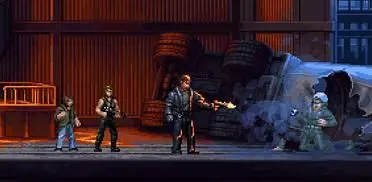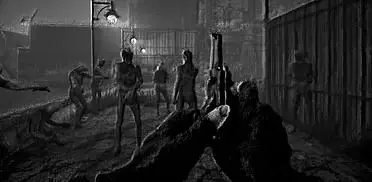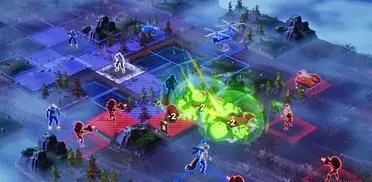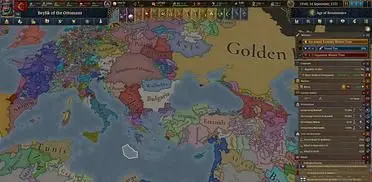The first thing you notice when jumping into a quick skirmish is that Victory at Sea isn't a particularly complex representation of naval warfare. Battles are arcadey action rather than deep simulation – you direct your ships forward, angling them so that your gun arcs cross over an enemy ship while doing your best to avoid broadsides in return. Once you've got the range you right-click on your target to send a barrage of shells raining down on them. If you've played Sid Meier's Pirates it's not a million miles away from that, albeit on a much larger scale. Ships have a few different weapons to deploy, typically a couple of long-range port and starboard cannons and some powerful but inaccurate torpedoes that need to be fired up close. Those are your most common tools, but some vessels do carry other weapons; destroyers pack depth charges for dealing with submarines, while carriers bring fighter-bombers that can deal a lot of damage, especially to ships that lack anti-aircraft defences.
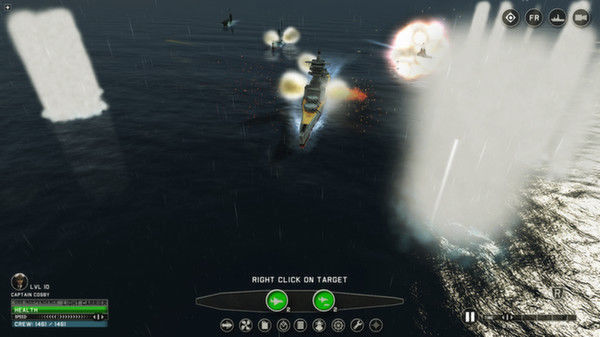 |
| Graphics are functional rather than attractive, but explosions and jets of displaced water look decent enough |
Maps are all placid stretches of water, with the action shown in a tight third-person camera that sticks a little too tightly to your ship for comfort. There is a free camera mode, but you can't pan the camera up and down, which means you'll have to switch over to a top-down tactical command map, where you can also issue orders to your fleet, to really get a sense of the battle's layout. Not a huge problem, but it feels a little awkward. Personally when I'm commanding a large group of units I like to shift the camera around a lot more than Victory at Sea wants me to.
In a nice touch you can pick a target in the tactical map mode and then set some of your vessels to automatic control, which simplifies bigger encounters. Generally the AI seemed solid, although when you leave it to its own devices you do run the risk of seeing a valuable cruiser smack head first into a wave of torpedoes. With an efficient time-scale mechanic that lets you slow down to pinpoint targets carefully or speed up to make chugging across those wide stretches of water less tedious, you never feel to swamped if you decide you want total control.
It's a shame that a few design choices let the combat down a bit. It's incredibly hard to tell ships apart in battle for one, and there's no mouse drag-and-select option, which makes cycling through your units far more fiddly than it needed to be. Also, starting locations are randomised for each battle – doesn't do much for strategic options when your star battleship starts off in the arse end of nowhere while your pathetic little torpedo boats square up to a heavy cruiser, especially as bigger ships are teeth-grindingly slow to catch up to the conflict, even if you're jamming down the throttle (do boats have throttles?).
Ultimately the biggest problem is that battles tend to feel very repetitive very quickly. You can only launch so many broadsides at an enemy cruiser before things begin to lose their shine. Special mission objectives like convoy protection or assault craft landings offer a tiny bit of variation, but not enough to stop the game feeling like it's repeating itself.
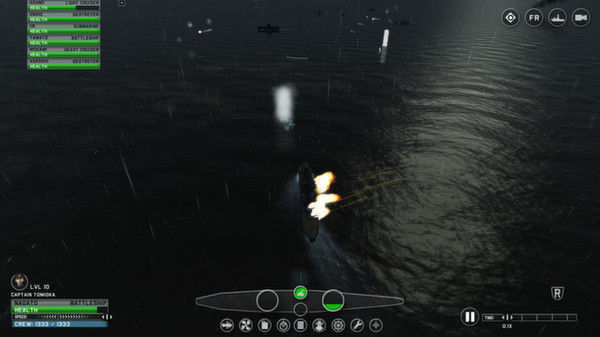 |
| After a brutal three-day battle culminating in a concentrated torpedo strike, the good ship Lollipop was finally brought down |
There are three main game modes to try out. Alongside several historical missions that give you a set list of units and pop you straight into the thick of things there's the option for a Point Battle that allows you to create your own naval skirmish, from small-scale destroyer duels to hectic, prolonged battles with dozens of ships. These are a good way of learning the basic mechanics, with the game's campaign mode as the main event.
Here you can choose to start off in a few different regions (Atlantic, Pacific and so on), and take control of most of the major WWII nations. After picking your admiral from a slightly underwhelming list of portraits, you jump straight into the campaign world map. Here you can zip around the ocean, ambushing enemy fleets or blockading ports. You start off with a single destroyer, a light attack ship that packs only a few gun emplacements, but picking off enemy vessels earns you war bonds which can then be spent upgrading your fleet. There's a bunch of different ships to choose from in each main category – destroyer, cruiser, battleship and so on – but they're presented to you in one big list which doesn't do a great job of explaining the difference between particular models. I ended up picking the ones with the coolest names, which admittedly isn't much of a strategy.
After a few introduction quests that let you build up a modest fleet, you'll slowly start picking off bigger and bigger targets. There's not much railroading – your job is go out and destroy things, and it's largely up to you how you do it. That lends the game a feel that's very reminiscent of Mount & Blade, a military sandbox where you build your own army up and choose where to deploy them. This is both a good and bad thing. I like not being pointed around everywhere like some glorified Fed-Ex deliveryman, but at the same time there's not all that much to do on the world map aside from hurl yourself at patrols and supply convoys until you level up.
You can grab unique quests from your home ports, but they're often incredibly frustrating. Take one particular mission where you're sent off to find a missing cargo ship. The game pointed me off towards the coast of Plymouth, where an objective marker indicated the last reported sighting of the missing vessel. Off I went, expecting a quick search of the nearby area and a relaxing cruise home, pulling in to port just in time for tea. Instead I circled around and around in increasingly large circles for about half an hour, finding absolutely nothing. I have no idea where that bastard ship went. The thing about the ocean is that there's rather a lot of it – it's not enough to vaguely wave me in a direction and then shrug your shoulders.
 |
| Battles are enjoyable, but quickly begin to feel repetitive |
Another mission early on had me defending a port from enemy assault. The attackers had some kind of high-tech ultra-fleet, packed to the gills with huge battleships and cruisers. I had three destroyers and a tugboat. I'm kidding there, of course. I didn’t have a tugboat. The point is that when missions aren't bafflingly vague or viciously difficult they're frustratingly designed. Escort missions fail the second an enemy fleet smashes into your supply convoy on the world map, rather than letting you jump into direct combat to defend them. Which you can normally do in random encounters, just not in the escort mission itself. Bizarre.
VICTORY AT SEA VERDICT
Victory at Sea is not without some charm. The basic ship combat is simplistic but fun, and though controlling large-scale battles is tricky and occasionally cumbersome it can be pretty satisfying. Pulling alongside a cruiser and obliterating it with a full broadside, or timing a torpedo strike just right to catch a fleeing destroyer amidships; these are fun core moments, but they’re poorly served by a lacklustre framework of repetitive gameplay, a frustrating camera and a limp campaign. If Victory at Sea was a budget game I’d say it’s a perfectly decent way to spend a few hours, but at the current price of $24.99 it doesn’t feel like good value for money.
TOP GAME MOMENT
Blasting outmatched destroyers and helpless cargo ships to pieces with your battleship’s long-range guns is pretty fun.
